The Story Of The Sailboat Rudder - Naca 0012 and 0015 foil
By Phil Keck #39 "S.S. Pubert" (5ar)This was my first attempt at making a rudder. When I decided to start this project, most people sounded like they were making rudders that were basically a flat board that had a rounded front and a slightly feathered edge, and it sounded like those rudders were working just fine. I like to make life difficult, so I decided to go for a real live NACA 0012 foil.
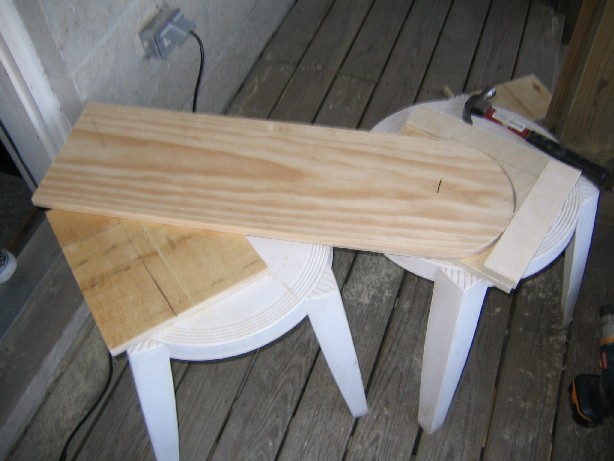
Here's how my rudder started out. Just a flat board. I don't own a power planer, and the thought of planing off more than a few millimeters of wood with a hand plane is enough to make me want to cry, so I decided to look around for another method.
Basically, you take some pink insulation foam from the hardware store and use that to make the wing shape. It's much easier to shape foam than it is to shape wood. I decided to stick the pieces of foam onto the wood rudder I already had, so the wood would provide the strong foundation, and the foam would create the wing shape.
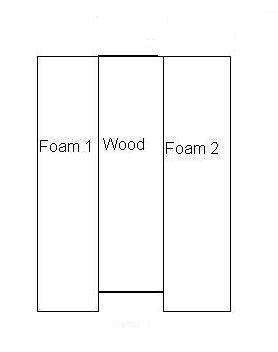
I didn't take pictures along the way because I forgot, so these pictures were done (poorly) in Paint. But they help explain what I did. Each of these images is looking at the bottom end of the rudder, as if you were a fish below the boat looking up at it.
First, I cut the pieces of foam that make the sides of the rudder. In the picture here, they are foam 1 and foam 2. Notice that they stick out past one end of the board. My wood board is a 1"x12" (which in reality is actually 3/4" by 11 1/4"). I wanted a rudder with a chord length of more than 11 1/4" (the chord length is the length from the front to the back), so I cut my foam pieces to be 12 inches long and 24 inches tall. I temporarily attached them to the board with masking tape.
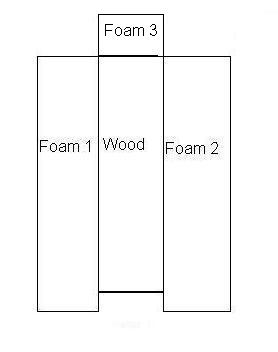
Then I stuck the nose piece on (it's foam 3 in the picture). I arbitrarily chose my nose piece to be 1 inch long, and it worked out well. It's 24 inches tall, just like foam 1 and foam 2 are.
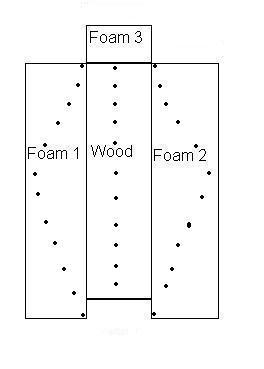
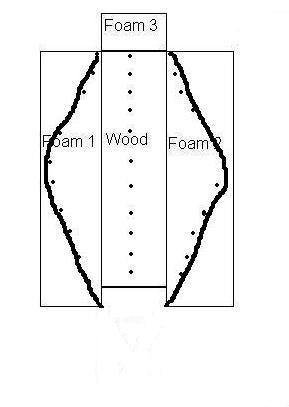
Then connect the dots. Mine actually did look about this sloppy, I just did it by hand.
Once I had the curve marked on both ends of foam 1 and foam 2, I peeled the foam pieces off of the wood. To shape them, I took a 1x2 that was about three or four feet long, and I stapled sandpaper along its length. All you do is run this sandpaper stick back and forth on the foam until you sand down to the curve you marked. Go slow at first because the foam can be shaped very quickly. Sand a bit, then check the ends of the board to see how far along you are. Sand, check, sand, check, sand, check. I also recommend you wear a dust mask for this part because you make an unbelievable amount of dust.
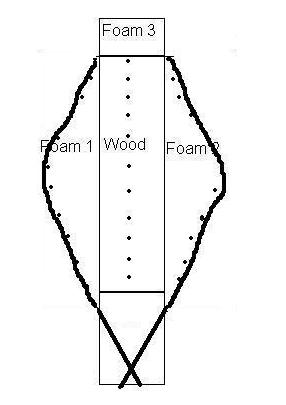
Once I had foam 1 and foam 2 shaped, I stuck them back on the wood board. I cut out a final piece of foam for the trailing edge. I made it about 5 inches long to start out with so that I had plenty of excess. All I did was take a straight edge and continue the lines from foam 1 and 2. It looked more or less like this. Then you shape it with the sanding stick just like the other pieces.
To shape the nose, I just took a piece of sand paper and pulled it taut around the nose piece. Then I ran it up and down along the foam until it was rounded. It only took a minute or so.
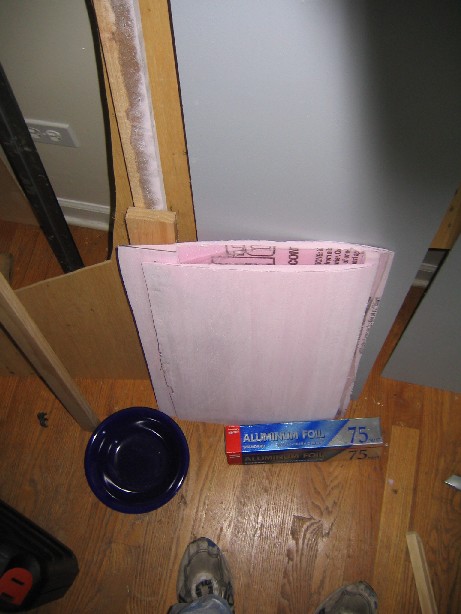
The actual finished pieces. You can kind of see my sanding stick standing up along the left edge of the pieces.

The finished pieces on the wood.
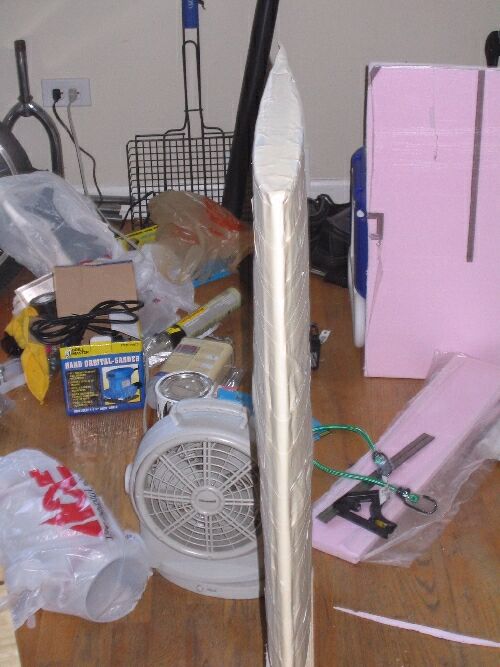
I wrapped the entire thing in masking tape because I was going to cover it in fiberglass and use the resin that they sell at home depot. It's a styrene based resin, and since the foam pieces are polystyrene, I assumed that they would dissolve on contact (but I didn't actually verify this with a scrap piece of foam). So here it is wrapped in masking tape.
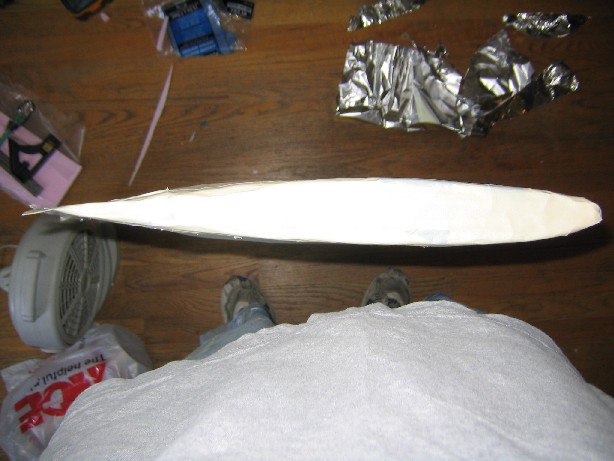
A view from the end. With a rudder this smooth, my boat will be negligibly faster than all of the others. It'll be great!
After this I wrapped it in fiberglass and coated it in resin. I'm terrible at doing this. The fiberglass was sloppy, and I got resin everywhere. The next time I do it, I'm going to wet out the fiberglass with resin in a tub first, and then drape that onto the rudder.
While my finished rudder is hideous and covered in gobs of resin, this whole process only took about two hours of actual work. So I'll just use the rudder I have now and I can always make a better one later. Making all of the calculations took up a lot of the time as well, and now that they're done, making more rudders will be a snap.
Calculate your rudder
To use this excel file, all you do is put the chord length of your rudder in inches into cell G-1 and hit enter. Don't actually type the word inches, just put the number. G-1 is the only cell you need to type into...if you type into any other cells, the formulas might get all mixed up.
There are two data sets that come up, one for a 0012 foil and one for a 0015 foil. The column labeled "Point #" is to help keep track of which point is which. The column labeled "Distance From Nose" gives you how far back that specific point should be placed from the nose. The column labeled "Distance From Centerline" is how far you measure left and right from that specific point.
For example, enter 10 as your chord length. For a 0012 foil, the chart tells us to measure 2/16" (or 1/8") back from the center of the nose of the rudder. Do this and then put a point there. It then tells us to measure 3/16" to the left of that point and 3/16" to the right of that point. Do that and put points there. Continue for all of the other points, and connect the dots.
